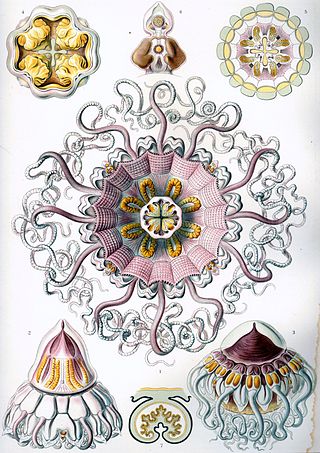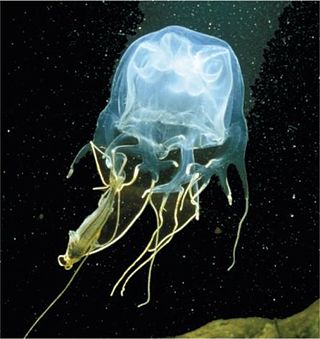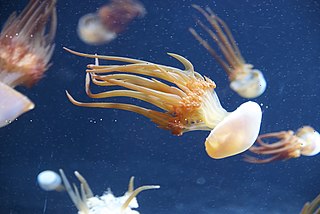
Rhizostomae or Rhizostomeae is an order of jellyfish. Species of this order have neither tentacles nor other structures at the bell's edges. Instead, they have eight highly branched oral arms, along which there are suctorial minimouth orifices. These oral arms become fused as they approach the central part of the jellyfish. The mouth of the animal is also subdivided into minute pores that are linked to coelenteron.

Cassiopea is a genus of true jellyfish and the only members of the family Cassiopeidae. They are found in warmer coastal regions around the world, including shallow mangrove swamps, mudflats, canals, and turtle grass flats in Florida, and the Caribbean and Micronesia. The medusa usually lives upside-down on the bottom, which has earned them the common name. These jellyfish partake in a symbiotic relationship with photosynthetic dinoflagellates and therefore, must lie upside-down in areas with sufficient light penetration to fuel their energy source. Where found, there may be numerous individuals with varying shades of white, blue, green and brown.

Chironex is a genus of box jellyfish in the family Chirodropidae. Their stings are highly venomous, and have caused human fatalities. Based on present knowledge, the genus is restricted to the central Indo-Pacific, ranging from southern Japan to northern Australia.

Crown jellyfishes are the six families of true jellyfish that belong to the order Coronatae. They are distinguished from other jellyfish by the presence of a deep groove running around the umbrella, giving them the crown shape from which they take their name. Many of the species in the order inhabit deep sea environments.

Periphyllidae is a family of jellyfish containing four genera and six species. The most well-known member of the family, Periphylla periphylla, is usually considered a deep-sea species, but it forms large blooms in surface waters of Norwegian fjords.

Wood-ear or tree ear, also translated wood jellyfish or tree jellyfish, can refer to a few similar-looking edible fungi used primarily in Chinese cuisine; these are commonly sold in Asian markets shredded and dried.

Chirodropidae is a family of venomous box jellyfish within the class Cubozoa. Like other members of the order Chirodropida, they have branched pedalia, in contrast to the unbranched pedalia of box jellyfish in the order Carybdeida. Each branch houses its own individual tentacle. Nematocyst composition and type can vary among individuals within this family based on body size and life stage. Like other box jellyfish, chirodropids can be found in coastal and shallow marine areas, but they have also been found to occur at benthic depths.

Atolla is a genus of crown jellyfish in the order Coronatae. The genus Atolla was originally proposed by Haeckel in 1880 and elevated to the monotypic family level, as Atollidae by Henry Bigelow in 1913. The six known species inhabit the mesopelagic zone. The medusae possess multiple lobes called lappets at the bell margin. Medusae also have eight tentacles, alternating with eight rhopalia, and twice as many lappets occur as tentacles.

Alatinidae is a family of box jellyfish within class Cubozoa, containing the following genera and species:

Lucernariidae is a family of stalked jellyfish containing two genera.

Rhopilema nomadica, the nomad jellyfish, is a jellyfish indigenous to tropical warm waters of the Indian and Pacific Oceans. Since 1970's it has been also found in Mediterranean Sea, where it entered via the Suez Canal. It has been found in the Eastern Mediterranean, off the coast of Lebanon, Israel, Turkey, and in the Aegean Sea off the coast of Greece. R. nomadica's body is light blue and the bell is rounded. It can grow up to 10 kg of weight, and its bell is commonly 40–60 cm in diameter, but can be up to 90 cm. The European Union lists it as one of the worst invasive marine species in European waters.

Rhizostomatidae is a family of cnidarians in the class Scyphozoa.

Chironex yamaguchii, commonly known as ハブクラゲ and as "hub jellyfish" due to erroneous machine translations, is a species of box jellyfish found in coastal waters around Japan, on Okinawa and the Ryukyu Islands, and in the Philippines. Discovered in 2009, it is highly venomous and has been the cause of several deaths in Japanese waters.

Chirodropus is a genus of box jellyfish in the family Chirodropidae.

Rhopilema esculentum, the flame jellyfish, is a species of jellyfish native to the warm temperate waters of the Pacific Ocean. It is a popular seafood in southeastern Asia. In the 1980s, research was undertaken in China into its aquaculture, and it is now bred in ponds in that country before being released into the sea to grow to a mature size suitable for the fishery.

Rhopilema verrilli, or mushroom cap jellyfish, is a species of jellyfish in the family Rhizostomatidae. They are cnidarian invertebrates distinguished by their mushroom-shaped medusae. The species does not have any tentacles; however, they still have stinging cells, called nematocysts, within their bells, which can produce mild stings to humans.

Sanderia malayensis is a species of jellyfish in the family Pelagiidae, native to the tropical Indo-Pacific. It has a complex life cycle and is thought to be venomous and to have caused injuries to humans.
Lychnorhizidae is a family of true jellyfish.
Linantha is a genus of crown jellyfish in the family Linuchidae. It is a monotypic genus and the only species is Linantha lunulata which was first described by the German biologist Ernst Haeckel in 1880. It is found in the tropical eastern Pacific Ocean in the vicinity of the Galápagos Islands.

Thysanostomatidae is a family of true jellyfish from the Indo-Pacific. The first sighting of Thysanostoma loriferum in Hong Kong; extending its known range from the Philippines, the Malay Archipelago, and Hawaii; was from the Hong Kong Jellyfish Citizen Science project and sightings on iNaturalist.


















